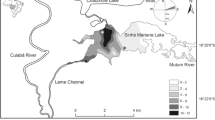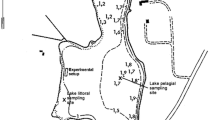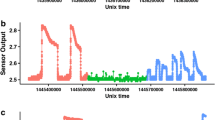Abstract
The effects of source and caging on the valve movements of the freshwater unionid mussel (Anodonta anatina) were studied in a reciprocal transplant experiment between a lake and its outflow. Caged mussels were moved and compared with those remaining in their natural environment on the lake or river bottom. At both sites, the mussels from the study site and the transplanted mussels from the opposite site were monitored simultaneously. In river the averaged weighted valve openness was higher and the number of valve movements was lower than in the lake. The mussels monitored in the lake exhibited a diurnal rhythm of valve movements which differed between the lake-bottom and the caged animals. Caging was found to increase valve openness. On the other hand, little variation appeared in valve openness between caged and bottom animals in the river, where diurnal rhythms were almost nonexistent. In the river the valve movements were more variable in respect to time than in the lake.
Similar content being viewed by others
References
Becker, K., L. Merlini, N. de Bertrand, L. F. d Alencastro & J. Tarradellas, 1992. Elevated levels of organotins in Lake Geneva: bivalves as sentinel organism. Bull. envir. Contam. Toxicol. 48: 37–44.
Borcherding, J., 1992: Another early warning system for the detection of toxic discharges in the aquatic environment based on valve movements of the freshwater mussel Dreissena polymorpha. In: D. Neumann & H. A. Jenner (eds), Limnologie aktuell — Vol. 4 — ‘The zebra mussel Dreissena polymorpha’. Gustaf Fischer Verlag, Stuttgart, Jena, New York: 127–146.
Borcherding, J. & M. Volpers, 1994a. The ‘Dreissena- monitor’ — First results on the application of this biological early warning system in the continuous monitoring of water quality. Wat. Sci. Technol. 29: 199–201.
Borcherding, J. & M. Volpers, 1994b. Der Dreissena-monitor — Untersuchungen zum Verhalten der Zebramuschlen im Rhein-Störfallbewertung in der kontinuierlichen Gewässerüberwachung. Wasser and Boden 46: 25–30.
Camusso, M., R. Balestrini, F. Muriano, M. Mariani, 1994. Use of freshwater mussel Dreissena polymorpha to assess trace metal pollution in the lower river Po (Italy). Chemosphere 29: 729–745.
Davids, C., 1964. The influence of suspensions of micro- organisms of different concentrations on the pumping and retention of food by the mussel (Mytilus edulis L.) Net. J. Sea Res. 2: 233–249.
Englund, V. & M. Heino, 1994a. Valve movement of Anodonta anatina and Unio tumidus (Bivalvia, Unionidae) in a eutrophic lake. Ann. zool. fern. 31: 257–262.
Englund, V. & M. Heino, 1994b. Valve movement of freshwater mussel Anodonta anatina: a reciprocal transplant experiment between two lakes. Ann. zool. fenn. 31: 417–423.
Englund, V., M. Heino & G. Melas, 1994. Field method for monitoring valve movements of bivalved molluscs. Wat. Res. 28: 2219–2221.
Goldberg, E. D., V. T. Bower, J. W. Farrington, G. Harvey, J. H. Martin, P. L. Parker, R. W. Risebrough, W. Robertson, E. Schneider & E. Gamble, 1978. The mussel watch. Envir. Conserv. 5: 101–125.
Green, R. H., R. C. Bailey, S. G. Hinch, J. L. Metcalfe & V. H. Young, 1989. Use of freshwater mussels (Bivalvia: Unionidae) to monitor the nearshore environment of lakes. J. Great Lakes Res. 15: 635–644.
Hemelraad, J., 1988. Accumulation and effects of cadmium in freshwater clams (Uniondae). Ph.D. Thesis. University of Utrecht.
Herve, S., 1991. Mussel incubation method for monitoring organochlorine compounds in freshwater recipients of pulp and paper industry. Department of Chemistry, University of Jyväskylä. Research report 36, Jyväskylä.
Hinch, S. G., R. C. Bailey & R. H. Green, 1986. Growth of Lampsilis radiata (Bivalvia: Unionidae) in sand and mud: A reciprocal transplant experiment. Can. J. Fish. aquat. Sci. 43: 548–552.
Hinch, S. G. & R. H. Green, 1989. The effects of source and destination on growth and metal uptake in freshwater clams reciprocally transplanted among southcentral Ontario lakes. Can. J. Zool. 67: 855–863.
Jokela, J., 1993. The selective environment of a freshwater clam: causes of selection and evolution of a live history strategy. Reports from the department of biology, University of Turku 32, Turku.
Jørgensen, C. B., 1990. Bivalve filter feeding: hydrodynamics, bioenergetics, physiology and ecology. Olsen & Olsen, Fredensborg, 140 pp.
Kinney, R. M., C. G. Manos, E. L. Mills, E. Mellina & D. J. Lisk, 1994. Zebra mussels (Dreissena polymorpha) as a biomonitoring tool for Sr90 contamination. Chemosphere 28: 729–735.
Kramer, K. J. M., H. A. Jenner & D. de Zwart, 1989. The valve movement response of mussels: a tool in biological monitoring. Hydrobiologia 188/189: 433–443.
Maciolek, J. A. & M. G. Tunzi, 1968. Microseston dynamics in a simple Sierra Nevada lake-stream system. Ecology 49: 60–75.
McCorkle, S., T. C. Shirley & T. H. Dietz, 1979. Rhythms of activity and oxycegen consumption in the common pond clam, Ligumia subrostrata (Say). Can. J. Zool. 57: 1960–1964.
Morton, B., 1970. The rhythmical behaviour of Anodonta cygnea L. and Unio pictorum L. and its biological significance. Forma et Functio 2: 110–120.
Pellinen, J., M. Ruokolainen, P. Mäkelä & J. Taskinen, 1994. Organic halogen compounds, EOX, in mussels from a clean lake and a pulp mill recipient. Chemosphere 29: 1515–1526.
Prest, H. F., W. M. Jarman, S. A. Burns, T. Weismüller, M. Martin & J. N. Huckins, 1992. Passive water sampling via semipermeable membrane devices (SPMDs) in concert with bivalves in the Sacramento/San Joaquin river delta. Chemosphere 25: 1811–1823.
Richardson, J. S., 1984. Effects of seston quality on the growth of the lake-outlet filter feeder. Oikos 43: 386–390.
Roseman, E. F., E. L. Mills, M. Rutzke, W. H. Gutenmann & D. J. Lisk, 1994. Absorption of cadmium from water by North American zebra and quagga mussels (Bivalvia: Dreissenidae). Chemosphere 28: 737–743.
Salánki, J., F. Lukacsovics & L. Hiripi, 1974. The effect of temperature variations on the rhythmic and periodic activity of the freshwater mussel (Anodonta cygnea L.). Ann. Biol. Tihany 41: 69–79.
Salánki, J. & K. V.-Balogh, 1989. Physiological background for using freshwater mussels in monitoring copper and lead pollution. Hydrobiologia 188/189 (Dev. Hydrobiol. 54: 445–454.
Sprung, M. & U. Rose, 1988. Influence of food size and food quality on the feeding of the mussel Dreissena polymorpha. Oecologia 77: 526–532.
Storey, A. W. & D. H. D. Edward, 1989. The freshwater mussel, Westralunio carteri Iredale, as a biological monitor of organochlorine pesticides. Aust. J. mar. Freshwat. Res. 40: 587–593.
Waller, D. L., J. J. Rach, W. G. Cope, L. L. Marking, S. W. Fisher & H. Dabrowska, 1993. Toxicity of candidate molluscicides to zebra mussels (Dreissena polymorpha) and selected nontarget organisms. J. Great Lakes Res. 19: 695–702.
Author information
Authors and Affiliations
Rights and permissions
About this article
Cite this article
Englund, V.P.M., Heino, M.P. Valve movement of the freshwater mussel Anodonta anatina: a reciprocal transplant experiment between lake and river. Hydrobiologia 328, 49–56 (1996). https://doi.org/10.1007/BF00016899
Received:
Revised:
Accepted:
Issue Date:
DOI: https://doi.org/10.1007/BF00016899




